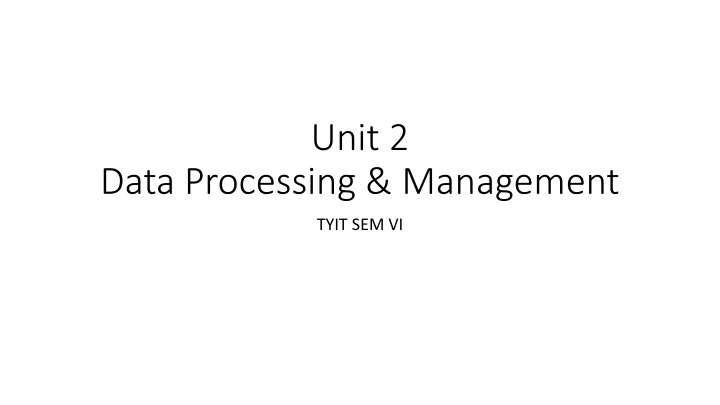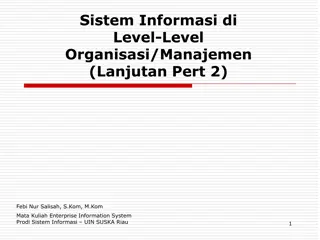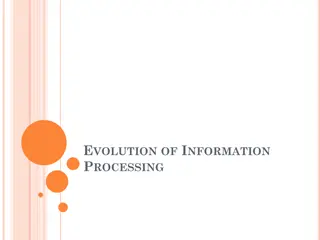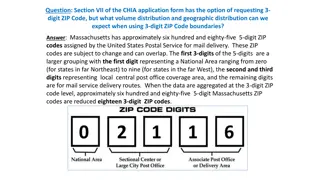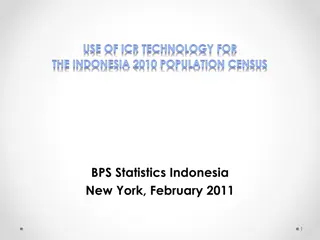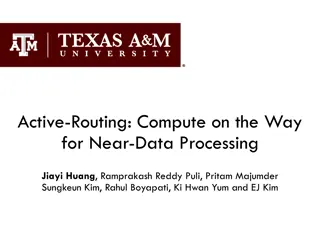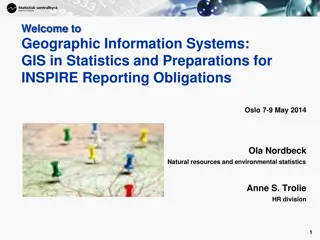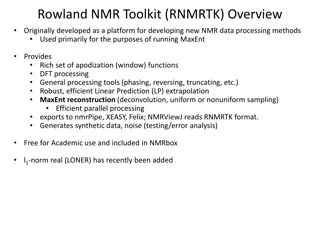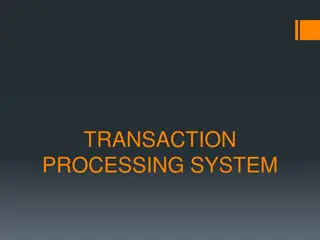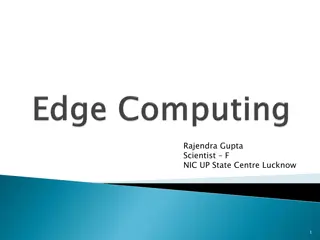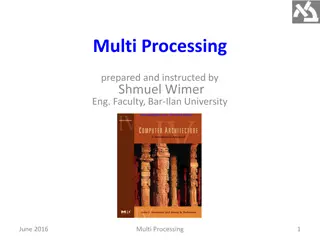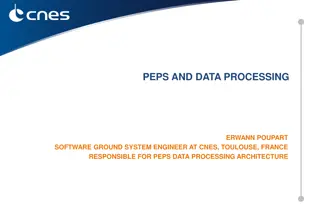Evolution of Data Processing Systems in Geographic Information Science
Data processing systems in Geographic Information Science have evolved from manual, analogue methods to advanced software and hardware components. The incorporation of Geographic Information Systems (GIS) has revolutionized the handling and analysis of geo-referenced data, making tasks like data capture, manipulation, and presentation more efficient. The emergence of GIS software with analytical functions has further enhanced the capabilities for deriving new geographical insights from existing data sources. The integration of hardware and software trends such as handheld computers and computer networks has enabled faster and more reliable data exchange, paving the way for more sophisticated data management and processing in the field of geo-information.
Download Presentation

Please find below an Image/Link to download the presentation.
The content on the website is provided AS IS for your information and personal use only. It may not be sold, licensed, or shared on other websites without obtaining consent from the author.If you encounter any issues during the download, it is possible that the publisher has removed the file from their server.
You are allowed to download the files provided on this website for personal or commercial use, subject to the condition that they are used lawfully. All files are the property of their respective owners.
The content on the website is provided AS IS for your information and personal use only. It may not be sold, licensed, or shared on other websites without obtaining consent from the author.
E N D
Presentation Transcript
Unit 2 Data Processing & Management TYIT SEM VI
Data processing system Refers to hardware and software components which are able to process, store and transfer data OR The components of systems that facilitate the management and processing of geo information.
Hardware and software trends Hand-held computers field surveyors with powerful tools, complete with GPS capabilities for instantaneous georeferencing To support these hardware trends, software providers continue to produce application programs and operating systems significantly more memory Computer networks allowing fast and reliable exchange of (spatial) data Mobile phones with data connection Bluetooth , wireless LAN , copper and fiber optic networks, dial-up
Geographic information systems GIS provides a range of capabilities to handle geo referenced data, including: Data capture and preparation, Data management (storage and maintenance), Data manipulation and analysis, and Data presentation. Earlier : analogue data sources were used, processing was done manually, and paper maps were produced Now : increased use of computers, digital information, software technology = geographic information systems
Data requirements Data sources, both spatial and non-spatial, from different national institutes, like national mapping agencies, geological, soil, and forest survey institutes, and national census bureaus. The data sources obtained may be from different time periods, and the spatial data may be in different scales or projections. With the help of a GIS, the spatial data can be stored in digital form in world coordinates. This makes scale transformations unnecessary, and the conversion between map projections can be done easily with the software. With the spatial data thus prepared, spatial analysis functions of the GIS can then be applied to perform the planning tasks.
GIS software The main characteristics : analytical functions that provide means for deriving new geo information from existing spatial and attribute data any package that provides support for only rasters or only objects, is not a complete GIS Well-known, full-fledged GIS packages include ILWIS, Intergraph s GeoMedia, ESRI s ArcGIS, and MapInfo from Map- packages Info Corp., QGIS 2.2, 2.8 & 3.14.
Software development in GIS Embedded GIS Professional GIS Desktop GIS Shared Geodata CAD based GIS Open GIS Internet GIS
GIS architecture and functionality Geographic information system in the wider sense consists of software, data, people, and an organization in which it is used. Functional components of GIS:
Spatial Data Infrastructure (SDI) Framework for sharing and integration of spatial data It depends on data, services, policies and application used Framework describes data, metadata, users and tools Standards for capturing, sharing and presentation have been developed by International Organization for Standardisation (ISO) and the Open Geospatial Consortium (OGC) Geo-webservices: software programs that act as an intermediate between geographic data(bases) and the users of the web
Basic software components of SDI Software client: to display, query & analyse spatial data ( web or desktop gis) Catalogue service: discovering, browsing & querying of metadata or spatial data (datasets) Spatial data service: allows delivery of data via internet Processing service: data, projection and scale transformation Spatial data repository: to store data GIS software: to create & update data
Stages of spatial data handling Spatial data capture and preparation Spatial data storage and maintenance Spatial query and analysis Spatial data presentation
Spatial data capture and preparation Data can be collected through : First hand observation primary source Published data secondary source Capturing can be done through scanning, photogrammetric, remote sensing, digitization of analog map, field survey etc From raw base data spatial data sets are derived Data conversion can be requied sometimes.
Data input methods & devices Data Acquisition coordinate entry via keyboard, digitizing table, stereoplotter Manual digitizing Existing graphics or Images Automatic / Semi automatic digitizing Scanner, line- following software Real time data GPS, Surveying Topographic maps, road network, Census data Existing digital data
Spatial data storage and maintenance Spatial data is organized in layers Representation of the real world has to be designed to reflect phenomena and their relationships as naturally as possible Vector data types describe an object through its boundary, thus dividing the space into parts that are occupied by the respective objects. The raster approach subdivides space into cells, mostly as a tessellation. These cells are called either cells or pixels in 2D, and voxels in 3D.
Raster storage It is stored in a file as a long list of values, preceded by a small list of extra data (the so-called fileheader ) that informs how to interpret the long list. The order of the cell values in the list can be but need not be left-to- right, top-to-bottom The header of the raster file will typically inform how many rows and columns the raster has, which encoding scheme is used, and what sort of values are stored for each cell. Raster files can be quite big data sets. For computational reasons, it is wise to organize the long list of cell values in such a way that spatially nearby cells are also near to each other in the list. This is why other encoding schemes have been devised.
Vector storage Boundary model for polygon
DBMS GIS software packages provide support for both spatial and attribute data GIS applications have been able to link to an external database to store attribute data All major GIS packages provide facilities to link with a DBMS and exchange attribute data with it. Spatial and attribute data are stored in separate structures, although they can now be stored directly in a spatial database.
Data maintenance To keep the data set up-to-date and as supportive as possible to the user community It deals with obtaining new data, and entering them into the system, possibly replacing outdated data. The purpose is to have an up-to- date stored data set available Updation of spatial data is required because many aspects of the real world changes continuously. Local change to the large spatial data set is more typically required. They should leave other spatial data within the same layer intact and correct.
Spatial query and analysis Spatial analysis: GIS operators that use spatial data to derive new geo information. GIS supports spatial decisions. Spatial decision support systems (SDSS): database, GIS software, models and a knowledge engine GIS use the spatial and non-spatial attributes of the data in a spatial database to provide answers to user questions. Analysis of spatial data can be defined as computing new information that provides new insight from the existing, stored spatial data.
Spatial data presentation The presentation of spatial data: in print or on-screen, in maps or in tabular displays, or as raw data The presentation may either be an end-product, for example as a printed atlas, or an intermediate product, as in spatial data made available through the internet
